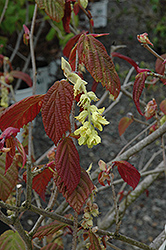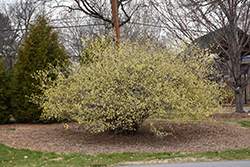Height: 6 feet
Spread: 8 feet
Sunlight:
![]()
![]()
![]()
Hardiness Zone: 7a
Description:
This radiant garden shrub is a harbinger of spring; dainty fragrant buttery-yellow flowers hang from bare branches in late winter, good habit of growth, and excellent fall color
Ornamental Features
Spike Winterhazel features delicate clusters of fragrant buttery yellow flowers hanging below the branches in late winter. It has green deciduous foliage. The heart-shaped leaves turn an outstanding yellow in the fall.
Landscape Attributes
Spike Winterhazel is a dense multi-stemmed deciduous shrub with a more or less rounded form. Its average texture blends into the landscape, but can be balanced by one or two finer or coarser trees or shrubs for an effective composition.
This is a relatively low maintenance shrub, and should only be pruned after flowering to avoid removing any of the current season's flowers. It has no significant negative characteristics.
Spike Winterhazel is recommended for the following landscape applications;
- Accent
- Mass Planting
- Hedges/Screening
- General Garden Use
Planting & Growing
Spike Winterhazel will grow to be about 6 feet tall at maturity, with a spread of 8 feet. It has a low canopy with a typical clearance of 1 foot from the ground, and is suitable for planting under power lines. It grows at a slow rate, and under ideal conditions can be expected to live for 40 years or more.
This shrub performs well in both full sun and full shade. It prefers to grow in average to moist conditions, and shouldn't be allowed to dry out. It is particular about its soil conditions, with a strong preference for rich, acidic soils. It is somewhat tolerant of urban pollution, and will benefit from being planted in a relatively sheltered location. Consider applying a thick mulch around the root zone in winter to protect it in exposed locations or colder microclimates. This species is not originally from North America.
Disclaimer - This resource is provided for informational purposes only and does NOT reflect current availability. Inventory varies seasonally, so we cannot guarantee that every plant will be in stock at all times - please contact your favourite GardenWorks location directly for current availability. It does not include our entire inventory of plants, so be sure to visit GardenWorks to see varieties that may not be represented on this list.


